I get a little problem with my project because I have a set of data, I plot it in order to get 2 curves and I would like to fit this plots by an exponential curve.
I watched this post : fitting exponential decay with no initial guessing. But my example is kind different.
This is what I'm getting with data :
My script is as following :
mask_G = np.bitwise_and( tbdata['G'] < 99.99, tbdata['GERR'] < 0.2)
mask_R = np.bitwise_and( tbdata['R'] < 99.99, tbdata['RERR'] < 0.2)
G_corrected = tbdata[mask_G]
R_corrected = tbdata[mask_R]
fig13 = plt.gcf()
fig13.set_size_inches(16, 9)
fig13, (ax1,ax2) = plt.subplots(1,2)
fig_error_g = ax1.plot(G_corrected['G'], G_corrected['GERR'], '.')
ax1.set_xlabel('G')
ax1.set_ylabel('GERR')
ax1.set_title('Evolution de GERR en fonction de G')
fig_error_r = ax2.plot(R_corrected['R'], R_corrected['RERR'], '.')
ax2.set_xlabel('R')
ax2.set_ylabel('RERR')
ax2.set_title('Evolution de RERR en fonction de R')
fig13.tight_layout()
plt.savefig('graphique.png')
plt.show()
I tried to write that, which based on scipy doc :
def exponential(x,a,b,c) :
return a * np.exp(-b * x) + c
xdata = G_corrected['G']
y = G_corrected['GERR']
ydata = y + 0.2 * np.random.normal(size=len(xdata))
popt, pcov = curve_fit(exponential, xdata, ydata)
but I get :
/home/user/Enthought/Canopy_64bit/User/lib/python2.7/site-packages/scipy/optimize/minpack.py:601: OptimizeWarning: Covariance of the parameters could not be estimated
category=OptimizeWarning)
Do you have any idea on how I can process ?
Thank you so much ;)
EDIT :
I tried to fit my plot like that :
mask_G = np.bitwise_and( tbdata['G'] < 99.99, tbdata['GERR'] < 0.2)
mask_R = np.bitwise_and( tbdata['R'] < 99.99, tbdata['RERR'] < 0.2)
G_corrected = tbdata[mask_G]
R_corrected = tbdata[mask_R]
params = np.polyfit(G_corrected['G'], np.log(G_corrected['GERR']),1)
a = params[0]
A = np.exp(params[1])
fig13 = plt.gcf()
fig13.set_size_inches(16, 9)
fig13, (ax1,ax2) = plt.subplots(1,2)
fig_error_g = ax1.plot(G_corrected['G'], (G_corrected['GERR']), '.')
fig_error_g = ax1.plot(G_corrected['G'], (A*np.exp(a*G_corrected['G'])),'.')
ax1.set_xlabel('G')
ax1.set_ylabel('GERR')
ax1.set_title('Evolution de GERR en fonction de G')
fig_error_r = ax2.plot(R_corrected['R'], np.log(R_corrected['RERR']), '.')
ax2.set_xlabel('R')
ax2.set_ylabel('RERR')
ax2.set_title('Evolution de RERR en fonction de R')
fig13.tight_layout()
plt.savefig('graphique.png')
plt.show()
and I get :
What do you think about the result ?

